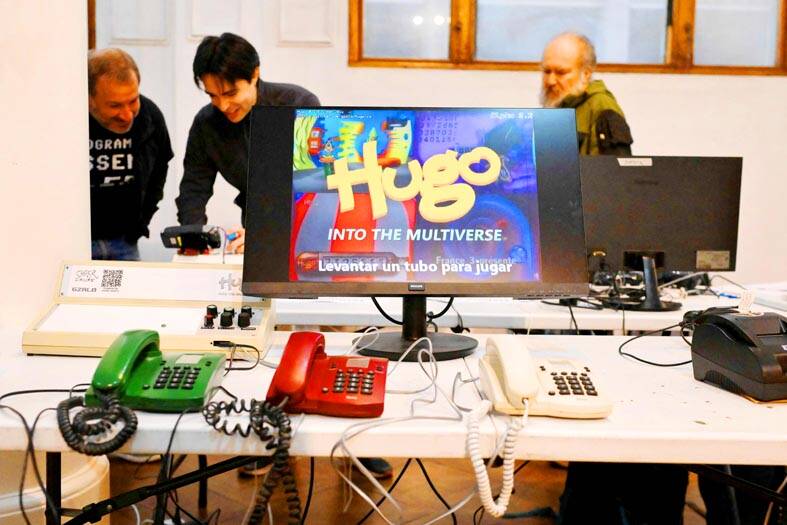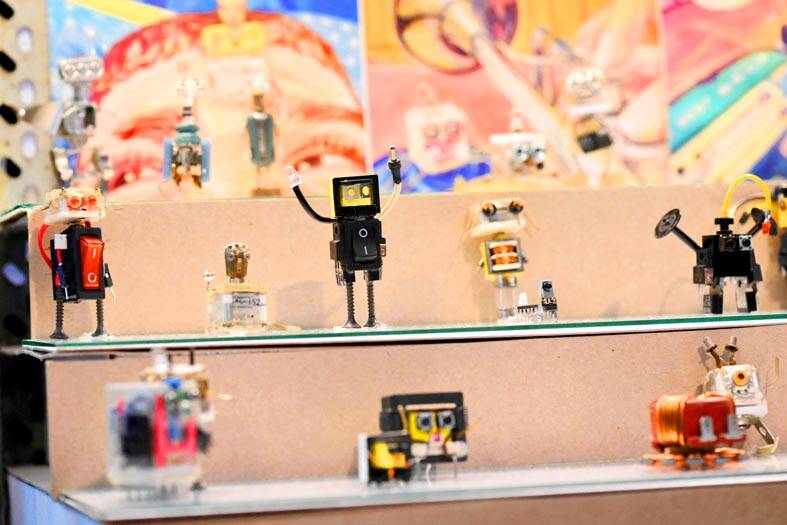Need a new gaming console? Just make one yourself with an old ventilator. Got an old payment terminal? Turn it into a camera.
These are just some of the creations of Argentina’s Cyber Dumpster Divers, a collective of ingenious tech aficionados who turn e-waste into new products.
“We experiment with technology by trying to recycle it and repurpose items that other people would simply throw away,” said Esteban Palladino, a musician who goes by the pseudonym Uctumi on social media.

Photo: AFP
“It’s a movement that has a charitable side, a techno-political side, and also a playful side,” he added.
Argentina produces an estimated 520,000 tonnes of electronic waste per year, making it fifth in the Americas after the US, Brazil, Mexico and Canada, a report released last year by the UN Research Institute for Social Development showed.
In 2022, the world generated a record 62 million tonnes, the report said.

Photo: AFP
The manifesto of the Cyber Dumpster Divers, who have dozens of members across Argentina, says that faced with “the immorality of equipment thrown in the trash, the ... diver rebels against the authority of the market.”
The waste pickers see themselves as revolutionaries at war with the tech “oligarchy.”
They call their provincial chapters cells, their manifesto is modeled on that of Karl Marx, and their posters feature a cyborg Che Guevara, who was born in Argentina.

Photo: AFP
The movement began in 2019 with hardware soup kitchens where people exchanged electronics parts.
During the COVID-19 pandemic, it gained impetus because many people suddenly needed computers to study or work at home.
In stepped the recyclers.
They resurrected old machines from the trash heap, fitted them with free operating systems and donated them to people and organizations in need.
The collective’s third annual meeting in Buenos Aires included a workshop on reviving defunct smartphones.
Visitors also lined up to play the “Ventilastation,” a gaming console made from an industrial fan, and to learn how to run artificial intelligence applications locally on old computers.
“Old things work,” read a slogan on the screen.
Electronics engineer Juan Carrique traveled 470km from the central province of Santa Fe to present “roboticlaje” or robotic recycling.
Carrique goes into schools to teach children how to use e-waste to build temperature sensors or motor controls.
“It’s not the same to buy something ready-made as having to make it yourself, using pieces of trash,” he said.
The 47-year-old diabetic is a fierce critic of planned obsolescence — companies programming products to become out of date after a certain period.
He used a free app to make his blood sugar monitor compatible with his phone, extending the device’s manufacturer-specified lifespan.
It is about “reclaiming the right to recognize when things work or don’t work, not being told they work or don’t work,” he said.
While giving a second life to old electronic devices might seem the height of geekiness, the Cyber Dumpster Divers are wary of the impact of smartphones, particularly on Argentina’s youth.
“It’s this ecosystem that is destroying the social fabric, destroying the psyche of young people,” said Cristian Rojo, one of the recyclers.

DISASTER: The Bangladesh Meteorological Department recorded a magnitude 5.7 and tremors reached as far as Kolkata, India, more than 300km away from the epicenter A powerful earthquake struck Bangladesh yesterday outside the crowded capital, Dhaka, killing at least five people and injuring about a hundred, the government said. The magnitude 5.5 quake struck at 10:38am near Narsingdi, Bangladesh, about 33km from Dhaka, the US Geological Survey (USGS) said. The earthquake sparked fear and chaos with many in the Muslim-majority nation of 170 million people at home on their day off. AFP reporters in Dhaka said they saw people weeping in the streets while others appeared shocked. Bangladesh Interim Leader Muhammad Yunus expressed his “deep shock and sorrow over the news of casualties in various districts.” At least five people,

It is one of the world’s most famous unsolved codes whose answer could sell for a fortune — but two US friends say they have already found the secret hidden by Kryptos. The S-shaped copper sculpture has baffled cryptography enthusiasts since its 1990 installation on the grounds of the CIA headquarters in Virginia, with three of its four messages deciphered so far. Yet K4, the final passage, has kept codebreakers scratching their heads. Sculptor Jim Sanborn, 80, has been so overwhelmed by guesses that he started charging US$50 for each response. Sanborn in August announced he would auction the 97-character solution to K4

SHOW OF FORCE: The US has held nine multilateral drills near Guam in the past four months, which Australia said was important to deter coercion in the region Five Chinese research vessels, including ships used for space and missile tracking and underwater mapping, were active in the northwest Pacific last month, as the US stepped up military exercises, data compiled by a Guam-based group shows. Rapid militarization in the northern Pacific gets insufficient attention, the Pacific Center for Island Security said, adding that it makes island populations a potential target in any great-power conflict. “If you look at the number of US and bilateral and multilateral exercises, there is a lot of activity,” Leland Bettis, the director of the group that seeks to flag regional security risks, said in an

ON THE LAM: The Brazilian Supreme Court said that the former president tried to burn his ankle monitor off as part of an attempt to orchestrate his escape from Brazil Former Brazilian president Jair Bolsonaro — under house arrest while he appeals a conviction for a foiled coup attempt — was taken into custody on Saturday after the Brazilian Supreme Court deemed him a high flight risk. The court said the far-right firebrand — who was sentenced to 27 years in prison over a scheme to stop Brazilian President Luiz Inacio Lula da Silva from taking office after the 2022 elections — had attempted to disable his ankle monitor to flee. Supreme Court judge Alexandre de Moraes said Bolsonaro’s detention was a preventive measure as final appeals play out. In a video made